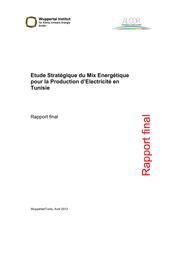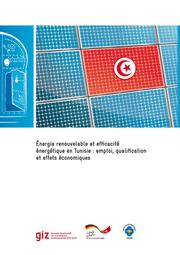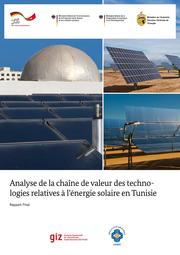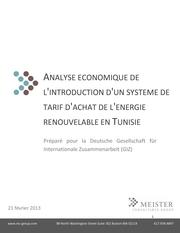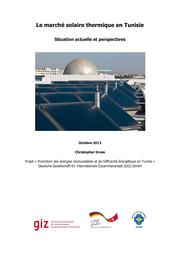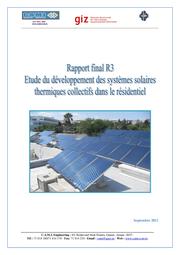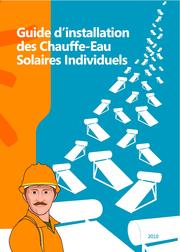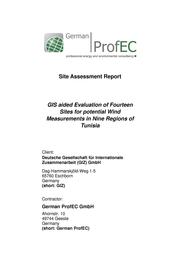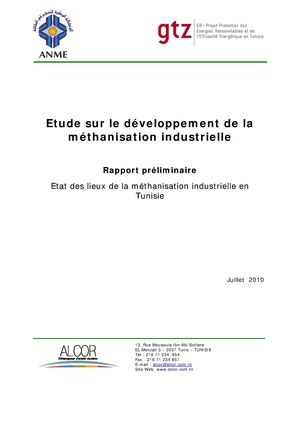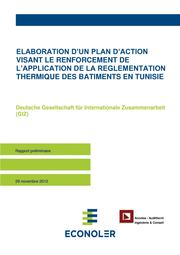Difference between revisions of "Promotion of Renewable Energies and Energy Efficiency in Tunisia"
***** (***** | *****) |
***** (***** | *****) m (→Wind Energy) |
||
| (50 intermediate revisions by 5 users not shown) | |||
| Line 1: | Line 1: | ||
| − | |||
| − | |||
| − | |||
| − | |||
= Overview<br/> = | = Overview<br/> = | ||
| − | Tunisia is heavily dependent on fossil fuels (oil, natural gas). Energy consumption increases by about 4% per year. The resulting '''greenhouse gas (GHG)''' emissions have harmful effects on the environment and the global climate. The competitiveness of Tunisian enterprises is affected by the energy intensity of the Tunisian economy. However, the potential of '''renewable energy (RE)''' and '''energy efficiency (EE)''' is still under-exploited. | + | [[Tunisia_Energy_Situation|Tunisia]] is heavily dependent on fossil fuels (oil, natural gas). Energy consumption increases by about 4% per year. The resulting '''greenhouse gas (GHG)''' emissions have harmful effects on the environment and the global climate. The competitiveness of Tunisian enterprises is affected by the energy intensity of the Tunisian economy. However, the potential of '''renewable energy (RE)''' and '''energy efficiency (EE)''' is still under-exploited. |
In order to meet these challenges in the energy sector, the '''National Agency for Energy Conservation ([http://www.anme.nat.tn/ ANME])''', a public institution under the supervision of the Ministry of Industry, was established in 1985 to ensure the implementation of a national policy in the field of energy management, including the promotion of energy efficiency and renewable energy. | In order to meet these challenges in the energy sector, the '''National Agency for Energy Conservation ([http://www.anme.nat.tn/ ANME])''', a public institution under the supervision of the Ministry of Industry, was established in 1985 to ensure the implementation of a national policy in the field of energy management, including the promotion of energy efficiency and renewable energy. | ||
| Line 14: | Line 10: | ||
In the following you will find an overview about the different technologies and applications the project works on. Further information about the different subjects can be found in the studies conducted by ANME and GIZ-ER2E. | In the following you will find an overview about the different technologies and applications the project works on. Further information about the different subjects can be found in the studies conducted by ANME and GIZ-ER2E. | ||
| − | + | ► Find more information about the '''[[Tunisia_Energy_Situation|Tunisia Energy Situation]]''' | |
| − | + | ► Download the [[:File:Promotion_des_Energies_Renouvelables_et_de_l’Efficacité_Energétique_-_Brochure_.pdf|'''Brochure of ER2E Projec'''t]]<span style="text-decoration: underline"></span> with information on project activities | |
| − | |||
| − | |||
<br/> | <br/> | ||
| + | = Renewable Energies<br/> = | ||
| + | Recent years have been marked with an ongoing discussion on the role of renewable energies in the Tunisian energy mix. As in most countries, this question is addressed with different expectations and objectives, typically related to the energy-policy triangle and its characteristic three key elements, namely cost-effectiveness, security of supply and environmental sustainability. Following the Tunisian revolution in January 2011, political and economic constraints have even become more important due to | ||
| + | *<span dir="ltr"></span>fossil fuel subsidies climbing at record levels, urging the government to increase energy prices | ||
| + | *<span dir="ltr"></span>rising energy demand and decreasing national gas ressources | ||
| + | *increasing unemployment rate | ||
| − | + | Within this context, several studies have been conducted by ER2E/GIZ in order to provide input to the discussions on the future energy mix, socio-economic benefits of renewable energy and energy efficiency as well as to the reform of the framework conditions for electricity production from renewable energy. | |
| − | |||
| − | |||
| − | |||
| − | |||
| − | |||
| − | |||
| − | |||
| − | |||
| − | |||
| − | |||
| − | |||
| − | |||
| − | |||
| − | Within this context, several studies | ||
<br/> | <br/> | ||
| − | {| cellspacing="1" cellpadding="5" border="0" align="center" style="width: | + | {| cellspacing="1" cellpadding="5" border="0" align="center" style="width: 776px; height: 263px" |
| + | |- | ||
| + | | style="width: 170px" | [[:File:FR_Mixénergie2030_Wuppertal_042012_GIZ.pdf|«Etude Stratégique du Mix Energétique pour la Production d’Electricité en Tunisie », Wuppertal Institut/Alcor/GIZ (2012)]]<br/> | ||
| + | | style="width: 156px" | [[Employment,_Qualification_and_Economic_Effects_-_Energy_Situation_in_Tunisia|« Renewable energy and energy efficiency in Tunisia – employment, qualification and economic effects », GWS/Alcor/GIZ (2012)]]<br/> | ||
| + | | style="width: 173px" | [[Value_Chain_Analysis_of_Solar_Energy_Technologies_in_Tunisia|«Analyse de la chaîne de valeur des technologies relatives à l’énergie solaire en Tunisie», Wuppertal Institut/adelphi/Ernst&Young/GIZ (2013)]] | ||
| + | | style="width: 207px" | [[:File:FR_REFIT_MCG_022013_GIZ.pdf|«Analyse économique de l'introduction d'un système de tarif d'achat de l'énergie renouvelable en Tunisie», Meister Consultants Group/GIZ (2013)]] | ||
|- | |- | ||
| − | | | + | | style="width: 170px" | [[File:FR Mixénergie2030 Wuppertal 042012 GIZ.pdf|border|center|180px|« Etude Stratégique du Mix Energétique pour la Production d’Electricité en Tunisie », Wuppertal Institut/Alcor/GIZ (2012)]]<br/> |
| − | + | | style="width: 156px" | | |
| − | | style="width: | + | [[File:FR EmploiEREE GWS 122012 GIZ.pdf|border|center|180px|Employment, Qualification and Economic Effects - Tunisia]]<br/> |
| − | |||
| − | [[File:FR | ||
| − | | | + | | style="width: 173px" | |
| − | + | [[File:Chaîne de valeur solaires en Tunisie.pdf|border|center|180px|Employment, Qualification and Economic Effects - Tunisia]]<br/><br/> | |
| − | |||
| − | |||
| − | | style="width: | + | | style="width: 207px" | [[File:FR REFIT MCG 022013 GIZ.pdf|border|center|180px|« Analyse économique de l'introduction d'un système de tarif d'achat de l'énergie renouvelable en Tunisie », Meister Consultant Group/GIZ (2013)]]<br/> |
| − | |||
|} | |} | ||
| − | <br/> | + | <br/>[[Promotion_of_Renewable_Energies_and_Energy_Efficiency_in_Tunisia#toc|►Go to Top]] |
| + | |||
| + | == Solar Water Heaters (SWH) == | ||
| − | + | The foundations of the solar thermal market in Tunisia were laid in the nineteen-eighties. Initially only developing slowly, installations of solar water heaters soared following the implementation of the PROSOL–Programme in 2005. Having successfully installed more than 40 square meters per 1,000 inhabitants, Tunisia is by far the leader in North Africa. | |
| − | + | The “PROSOL”-programme started revitalizing the Tunisian solar water heater market in 2005. Designed as a financing scheme, it consists of a capital cost subsidy up to 55 Euros, provided by the Tunisian government, a loan mechanism for domestic customers to purchase SWHs, paid back through the electricity bill and discounted rates on the loans. The suppliers, who act as indirect lenders for their customers, must be accredited by the Tunisian Energy Agency (ANME). Clients eligible for PROSOL must have an electricity service contract with the Tunisian Electricity and Gas Company (STEG). The “Collective Prosol Programme” in Tunisia, a subsidy programme for solar thermal installations in the tertiary sector, started back in 2007. The application rate was low first, but then the commercial solar thermal market gained certain momentum. ANME designed the financial scheme in cooperation with the United Nations Environment Programme (UNEP) in 2008. The programme aimed at the installation of 60,000 m2 of collector surface in the tertiary sector between 2008 and 2011, including 80 hotels. This aim has been missed by far at the end of 2011. The main great achievement of the PROSOL programme has been to succeed in shifting a cashbased market to a credit-based market reducing the weight of such investment on the purchasing power of the population. According to estimates made by ANME, solar thermal technology for water heating could satisfy 70% to 80% of the water heating needs in the residential sector. As of end of 2012, a total of 490.000 m2 have been installed since the introduction of the "PROSOL"-programme in the residential sector for domestic hot water purposes. These SWH are thermosiphon systems with mainly flatplate and some evacuated tube collectors. The number of SWH companies eligible within Prosol has reached 47 by the end of 2010. By the same time, 1,042 installers were active in the market.<ref>"Etude du développement des systèmes solaires thermiques collectifs dans le résidentiel", 2011, CAMI</ref> | |
| − | + | <br/><u>For detailed analysis on the Tunisian SWH market, please refer to:</u> | |
| − | + | [[:File:Le_marché_CES_en_Tunisie.pdf|"Le marché solaire thérmique en Tunisie, Situation actuelle et perspectives" (2013), Christopher Gross, GIZ (en francais)]] | |
| − | + | {| cellspacing="1" cellpadding="5" border="0" align="left" style="width: 100%" | |
| + | |- | ||
| + | | style="width: 209px" | | ||
| + | <br/>[[File:Le marché CES en Tunisie.pdf|border|left|180px|File:Le marché CES en Tunisie.pdf]] | ||
| − | " | + | | style="width: 552px" | |
| + | This study gives insight into international market structures and links them to recent market developments in Tunisia. Particular emphasis is laid on the analysis of the policy scheme, installed capacities, market products and main supply structures. To close, the study evaluates the profitability for residential investors, currently representing the main purchasing group.<br/>The study investigates the current state of Tunisia’s market for solar water heaters with a focus on (i) the links between national and international market developments (ii) the effectiveness of policy in procuring additional capacity (iii) a description of market products and main supply structures (iv) and the profitability of residential investors who are the largest consumers of solar water heaters.<br/>The results show that the solar thermal market in its current state is characterized by various unsustainable events. As a consequence there is an implied risk that solar thermal as a whole could gain a negative reputation among the general public, damaging this emerging industry. This study develops recommendations for policy makers and market participants to counteract this development. | ||
<br/> | <br/> | ||
| − | + | |} | |
<br/> | <br/> | ||
| − | [[File:FR CES Residence Collectif CAMI 2011 GIZ.pdf| | + | Within the framework of the project ER2E (GIZ) in collaboration with ANME two more publications have been developed. The first one addresses the deployment of SWH beyond small-scale residential appliacations in multi-family / apartment blocks. The second one is a practical guide which sums up best practice installation procedures.<br/> |
| + | |||
| + | {| cellspacing="1" cellpadding="5" border="0" align="left" style="width: 759px; height: 181px;" | ||
| + | |- | ||
| + | | style="width: 210px" | [[File:FR CES Residence Collectif CAMI 2011 GIZ.pdf|border|left|180px|File:FR CES Residence Collectif CAMI 2011 GIZ.pdf|link=https://energypedia.info/index.php?title=File:FR_CES_Residence_Collectif_CAMI_2011_GIZ.pdf&page=1&pk_campaign=TunisiaEnergy&pk_kwd=TunisiaEnergy]] | ||
| + | | style="width: 526px;" | | ||
| + | This study adresses technical opportunities for the deployment of SWH in multi-family / apartment buildings in Tunisia.<br/><br/>"Etude du développement des systèmes solaires thermiques collectifs dans le résidentiel", 2011, CAMI | ||
| − | + | |- | |
| + | | style="width: 210px" | [[File:GuideCESI Ecoser 112010.pdf|border|left|180px|downloaded here:]] | ||
| + | | style="width: 526px;" | | ||
| + | A practical guide for the installation of SWH in Tunisia. | ||
| − | <br/> | + | |} |
| + | <div style="clear: both">[[Promotion_of_Renewable_Energies_and_Energy_Efficiency_in_Tunisia#toc|►Go to Top]]<br/></div> | ||
== Wind Energy<br/> == | == Wind Energy<br/> == | ||
| Line 97: | Line 98: | ||
<u>For more information about wind energy in Tunisia, see:</u><br/> | <u>For more information about wind energy in Tunisia, see:</u><br/> | ||
| − | + | ||
| − | + | *[[:File:WindSiteAssessment_ProfEC_102011.pdf|Wind site assessment Tunisia, German ProfEC/GIZ, 2011]] (in french)<br/> | |
| − | + | ||
| − | {| cellspacing="1" cellpadding="5" border="0" align="left" style="width: | + | {| cellspacing="1" cellpadding="5" border="0" align="left" style="width: 753px; height: 181px;" |
|- | |- | ||
| style="width: 31px" | | | style="width: 31px" | | ||
| − | [[File:WindSiteAssessment ProfEC 102011.pdf|left|180px| | + | [[File:WindSiteAssessment ProfEC 102011.pdf|border|left|180px|WindSiteAssessment ProfEC 102011.pdf]]<br/> |
| − | | style="width: | + | | style="width: 512px;" | |
<br/>The purpose of the site assessment was to elaborate an overview and to derive recommendations about which sites are most suitable for potential wind farm planning activities, thereby respecting the existing infrastructure, wind resource databases and a minimum space for 50 MW installed capacity at each site.<br/> | <br/>The purpose of the site assessment was to elaborate an overview and to derive recommendations about which sites are most suitable for potential wind farm planning activities, thereby respecting the existing infrastructure, wind resource databases and a minimum space for 50 MW installed capacity at each site.<br/> | ||
| − | | | + | |- |
| − | + | | colspan="2" style="width: 737px;" | | |
| − | + | *[[:File:FR_ÉtudeFaisabilité_ProfecDFIC_032011_GIZ_-_ANME.pdf|Feasibility study for a wind parc within the autoproduction framework, German ProfEC/DFIC/GIZ, 2011]] (in french) | |
| − | |||
| − | |||
| − | |||
| − | |||
| − | |||
| − | |||
| − | |||
| − | |||
| − | |||
| − | |||
| − | |||
| − | |||
| − | |||
| − | |||
| − | |||
| − | |||
| − | |||
| − | |||
| − | |||
| − | |||
| − | |||
|- | |- | ||
| style="width: 31px" | | | style="width: 31px" | | ||
| − | [[File:FR ÉtudeFaisabilité ProfecDFIC 032011 GIZ - ANME.pdf|left|180px| | + | [[File:FR ÉtudeFaisabilité ProfecDFIC 032011 GIZ - ANME.pdf|border|left|180px|Feasibility study for a wind parc within the autoproduction framework, German ProfEC/DFIC/GIZ, 2011]] |
| − | | style="width: | + | | style="width: 512px;" | |
<br/>The objective of the study was to analyse the technical and economical feasibilty of a 60 MW or 120 MW wind farm at the site of Thala in the West of Tunisia.<br/> | <br/>The objective of the study was to analyse the technical and economical feasibilty of a 60 MW or 120 MW wind farm at the site of Thala in the West of Tunisia.<br/> | ||
|} | |} | ||
| + | <div style="clear: both">[[Promotion_of_Renewable_Energies_and_Energy_Efficiency_in_Tunisia#toc|►Go to Top]]<br/></div> | ||
| − | |||
| − | + | == Photovoltaics == | |
| − | + | A continuing decline in the price of photovoltaics in 2012 has made photovoltaic projects more economically feasible in many parts the world, including promising emerging markets. This could imply a unique strategic opportunity for Tunisia, which is endowed with high levels of solar insolation and a strong political will to diversify its electricity mix. Targeting significant scale-up potentials will drive costs down and will determine whether Tunisia makes use of its opportunity to benefit from cheap solar electricity in the near future. | |
| − | + | However, although international prices for residential photovoltaic systems dropped by 40 percent since 2010, prices in Tunisia have only decreased by 27 percent over the same period. Average price levels are still 25 percent above international levels. Lack of competition and transparency lead to market distortions and price variations in the range of 50 percent per system installed. In 2012 only 4 of 41 suppliers offered system prices close to international levels. | |
| − | + | In an effort to stimulate the photovoltaic market, the Tunisian government has introduced first instruments of policy support. Dedicated to residential customers, the implementation of the program PROSOL-Elec in 2010 has mobilized investments to develop about 4 MWp of photovoltaic capacity, 90 percent of which is accounted for by systems of 1-2 kWp capacity. The program provides a grant of 30 % of investment costs (maximum contribution: 2,300 TND per kWp) and access to an optional concessional to cover additional expenditures. Dedicated to the tertiary and industrial sector, the self-production scheme has so far not been successful at developing PV projects. Overall the market for photovoltaics is still poorly developed and has only focused on small-scale residential systems. Photovoltaic plants of commercial scale (up to 1 MWp) and large-scale (more than 1 MWp) have not yet been realized in Tunisia. | |
| − | |||
| − | |||
| − | + | Tunisia is currently revising its Solar Plan with the goal of accelerating the development of renewables, including PV, and facilitating legal procedures. In addition, decisions on the future electricity mix for Tunisia are expected for the coming months, which may result in a 10% PV share in electricity production until 2030, resulting in 1,5 to 2 GWp of installed PV capacity by 2030. | |
| − | |||
| − | |||
| − | |||
| − | |||
| − | |||
| − | |||
| − | |||
| − | |||
<br/> | <br/> | ||
| − | + | <u>For detailed analysis on the Tunisian photovoltaic market, please refer to:</u> | |
| − | |||
| − | |||
| − | + | [[:File:MarchéPhotovoltaiqueTunisie_GIZ_082013.pdf|"Le marché photovoltaïque en Tunisie, Situation actuelle et perspectives" (2013), Christopher Gross, GIZ (en francais)]] | |
| − | |||
| − | |||
| − | |||
| − | |||
| − | |||
| − | [[:File: | ||
<br/> | <br/> | ||
| − | {| cellspacing="1" cellpadding="5" border="0" align="left" style="width: 754px; | + | {| cellspacing="1" cellpadding="5" border="0" align="left" style="width: 754px; height: 181px" |
|- | |- | ||
| style="width: 31px" | | | style="width: 31px" | | ||
| − | [[File:MarchéPhotovoltaiqueTunisie GIZ 082013.pdf|180px| | + | [[File:MarchéPhotovoltaiqueTunisie GIZ 082013.pdf|border|left|180px|"Le marché photovoltaïque en Tunisie Situation actuelle et perspectives" (2013), C.Gross/GIZ (en francais)]] |
| style="width: 691px" | | | style="width: 691px" | | ||
| Line 191: | Line 153: | ||
|} | |} | ||
| − | + | <div style="clear: both">[[Promotion_of_Renewable_Energies_and_Energy_Efficiency_in_Tunisia#toc|►Go to Top]]<br/></div> | |
| − | < | ||
| − | |||
| − | |||
| − | |||
| − | |||
| − | |||
| − | <br/> | ||
| − | |||
| − | < | ||
| − | |||
| − | |||
| − | |||
| − | |||
| − | |||
| − | |||
| − | |||
| − | |||
| − | |||
| − | |||
| − | |||
| − | |||
| − | |||
== Concentrating Solar Power<br/> == | == Concentrating Solar Power<br/> == | ||
Concentrating Solar Power (CSP) plays so far no role in Tunisia. A 50 MW parabolic trough plant is currently planned by STEG with financing from an international consortium. Within the preliminary energy mix objectives for 2030, an overall installed CSP capacity of between 400 and 600 MW is foreseen. Despite the advantage of the possibility of CSP plants to even store the thermal energy and afterwards produce the electricity when it is used, e.g. during night time, the technology is facing considerable problems due to its relatively high required investment costs and rapidly falling prices of other renewable energy technologies.<br/> | Concentrating Solar Power (CSP) plays so far no role in Tunisia. A 50 MW parabolic trough plant is currently planned by STEG with financing from an international consortium. Within the preliminary energy mix objectives for 2030, an overall installed CSP capacity of between 400 and 600 MW is foreseen. Despite the advantage of the possibility of CSP plants to even store the thermal energy and afterwards produce the electricity when it is used, e.g. during night time, the technology is facing considerable problems due to its relatively high required investment costs and rapidly falling prices of other renewable energy technologies.<br/> | ||
| − | + | [[Promotion_of_Renewable_Energies_and_Energy_Efficiency_in_Tunisia#toc|►Go to Top]]<br/> | |
| − | |||
| − | <br/> | ||
== Small Scale Hydro Generation == | == Small Scale Hydro Generation == | ||
| Line 226: | Line 164: | ||
The Tunisian public water supplier SONEDE (Société Nationale d’Exploitation et de Distribution de l’Eau) has some 1300 water pumping stations. Electricity consumption of the pumping stations is substantial with the biggest stations consuming more than 1 GWh of electricity per year. Likewise, the drinking water network has substantial potential for generating electricity by using the excess of pressure in the network system.<br/> | The Tunisian public water supplier SONEDE (Société Nationale d’Exploitation et de Distribution de l’Eau) has some 1300 water pumping stations. Electricity consumption of the pumping stations is substantial with the biggest stations consuming more than 1 GWh of electricity per year. Likewise, the drinking water network has substantial potential for generating electricity by using the excess of pressure in the network system.<br/> | ||
| − | More information about small scale hydro generation potentials within the SONEDE network can be found in the study [[:File: | + | More information about small scale hydro generation potentials within the SONEDE network can be found in the study [[:File:FR_PotentielMHP_Entec_032012_GIZ_-_ANME.pdf|"Appui de la SONEDE dans le developpement de petites centrales hydroéléctriques sur son résau d'eau potable", entec/GIZ (2012)]] |
| − | [[File:FR | + | [[File:FR Méthanisation industrielle Alcor 2010 GIZ - ANME.pdf|thumb|left]] |
| − | < | + | <u>The purpose of these regulations is to define the minimal standards to be applied for the design and construction of residential and tertiary sector buildings by:</u> |
| − | |||
| − | |||
| − | |||
| − | |||
| − | |||
| − | |||
| − | |||
| − | |||
| − | |||
| − | |||
| − | |||
| − | |||
| − | |||
| − | |||
| − | |||
| − | |||
| − | |||
| − | |||
| − | |||
| − | < | ||
| − | |||
| − | |||
| − | |||
| − | |||
| − | |||
| − | |||
| − | |||
| − | |||
| − | |||
| − | |||
| − | |||
| − | |||
| − | |||
| − | |||
| − | |||
| − | |||
| − | |||
| − | |||
| − | |||
| − | |||
| − | |||
| − | |||
| − | |||
| − | |||
| − | |||
| − | |||
*developing minimum technical energy-saving specifications for projects to construct or extend office buildings and multi-family residential buildings; | *developing minimum technical energy-saving specifications for projects to construct or extend office buildings and multi-family residential buildings; | ||
*establishing blueprint auditing for new projects and extension projects; | *establishing blueprint auditing for new projects and extension projects; | ||
| Line 286: | Line 178: | ||
For further information, see: | For further information, see: | ||
| − | [[:File: | + | [[:File:FR_RéglementationThermique_Econoler_022013_GIZ.pdf|"Etude sur l'application de la reglementation thermique des batiments en Tunisie", Econoler/Accelea/GIZ (2012)]] |
| − | |||
| − | |||
| − | |||
| − | |||
| − | |||
| − | |||
| + | [[File:FR RéglementationThermique Econoler 022013 GIZ.pdf|thumb|left|180px]] | ||
| + | <div style="clear: both">[[Promotion_of_Renewable_Energies_and_Energy_Efficiency_in_Tunisia#toc|►Go to Top]]<br/></div> | ||
== Cogeneration == | == Cogeneration == | ||
Cogeneration development in Tunisia was launched in 2001, with the publication of the December 2002 decree (2002- 3232) establishing rules and provisions for the implementation of cogeneration projects. Despite the high potential of around 600 MW estimated by ANME (430 MW in the industrial sector and 170 MW in the tertiary sector), the established objectives have yet to be attained. As of end 2012, total installed capacity was around 36 MW with a yearly production of 236 GWh. | Cogeneration development in Tunisia was launched in 2001, with the publication of the December 2002 decree (2002- 3232) establishing rules and provisions for the implementation of cogeneration projects. Despite the high potential of around 600 MW estimated by ANME (430 MW in the industrial sector and 170 MW in the tertiary sector), the established objectives have yet to be attained. As of end 2012, total installed capacity was around 36 MW with a yearly production of 236 GWh. | ||
| − | <br/> | + | [[Promotion_of_Renewable_Energies_and_Energy_Efficiency_in_Tunisia#toc|►Go to Top]]<br/> |
= Further Information = | = Further Information = | ||
| − | *[[Tunisia Energy Situation|Tunisia | + | *[[Tunisia_Energy_Situation|Tunisia Energy Situation]] |
| + | *[[Financing_Solar_Energy_in_Tunisia|Financing Solar Energy in Tunisia]]<br/> | ||
| + | *[[Dynamic_Cash_Flow_Analysis_of_Photovoltaic_Projects_in_Tunisia|Dynamic Cash Flow Analysis of Photovoltaic Projects in Tunisia]]<br/> | ||
| + | *[[Opportunity_Study_for_Solar_Thermal_Systems_in_the_Tertiary_and_Industrial_Sector|Opportunity Study for Solar Thermal Systems in the Tertiary and Industrial Sector]]<br/> | ||
| + | *[[Enabling_PV_in_the_MENA_Region|Enabling PV in the MENA Region]] | ||
| + | *[[Droit_au_But_Workshop|Droit au But]] | ||
<br/> | <br/> | ||
| + | |||
| + | [[Promotion_of_Renewable_Energies_and_Energy_Efficiency_in_Tunisia#toc|►Go to Top]]<br/> | ||
= References = | = References = | ||
| Line 310: | Line 205: | ||
<references /><br/> | <references /><br/> | ||
| + | [[Category:Wind]] | ||
| + | [[Category:Solar]] | ||
| + | [[Category:Hydro]] | ||
| + | [[Category:Bioenergy]] | ||
[[Category:Tunisia]] | [[Category:Tunisia]] | ||
Latest revision as of 09:31, 15 May 2015
Overview
Tunisia is heavily dependent on fossil fuels (oil, natural gas). Energy consumption increases by about 4% per year. The resulting greenhouse gas (GHG) emissions have harmful effects on the environment and the global climate. The competitiveness of Tunisian enterprises is affected by the energy intensity of the Tunisian economy. However, the potential of renewable energy (RE) and energy efficiency (EE) is still under-exploited.
In order to meet these challenges in the energy sector, the National Agency for Energy Conservation (ANME), a public institution under the supervision of the Ministry of Industry, was established in 1985 to ensure the implementation of a national policy in the field of energy management, including the promotion of energy efficiency and renewable energy.
In November 2003, the project “Promotion of Renewable Energy and Energy Efficiency” (ER2E) was initiated in the context of Tunisian-German cooperation to assist the ANME in developing appropriate approaches for energy management in Tunisia. The project is funded by the Federal Ministry for Economic Cooperation and Development (BMZ) and implemented by the Deutsche Gesellschaft für Internationale Zusammenarbeit (GIZ) and the ANME.
In the following you will find an overview about the different technologies and applications the project works on. Further information about the different subjects can be found in the studies conducted by ANME and GIZ-ER2E.
► Find more information about the Tunisia Energy Situation
► Download the Brochure of ER2E Project with information on project activities
Renewable Energies
Recent years have been marked with an ongoing discussion on the role of renewable energies in the Tunisian energy mix. As in most countries, this question is addressed with different expectations and objectives, typically related to the energy-policy triangle and its characteristic three key elements, namely cost-effectiveness, security of supply and environmental sustainability. Following the Tunisian revolution in January 2011, political and economic constraints have even become more important due to
- fossil fuel subsidies climbing at record levels, urging the government to increase energy prices
- rising energy demand and decreasing national gas ressources
- increasing unemployment rate
Within this context, several studies have been conducted by ER2E/GIZ in order to provide input to the discussions on the future energy mix, socio-economic benefits of renewable energy and energy efficiency as well as to the reform of the framework conditions for electricity production from renewable energy.
Solar Water Heaters (SWH)
The foundations of the solar thermal market in Tunisia were laid in the nineteen-eighties. Initially only developing slowly, installations of solar water heaters soared following the implementation of the PROSOL–Programme in 2005. Having successfully installed more than 40 square meters per 1,000 inhabitants, Tunisia is by far the leader in North Africa.
The “PROSOL”-programme started revitalizing the Tunisian solar water heater market in 2005. Designed as a financing scheme, it consists of a capital cost subsidy up to 55 Euros, provided by the Tunisian government, a loan mechanism for domestic customers to purchase SWHs, paid back through the electricity bill and discounted rates on the loans. The suppliers, who act as indirect lenders for their customers, must be accredited by the Tunisian Energy Agency (ANME). Clients eligible for PROSOL must have an electricity service contract with the Tunisian Electricity and Gas Company (STEG). The “Collective Prosol Programme” in Tunisia, a subsidy programme for solar thermal installations in the tertiary sector, started back in 2007. The application rate was low first, but then the commercial solar thermal market gained certain momentum. ANME designed the financial scheme in cooperation with the United Nations Environment Programme (UNEP) in 2008. The programme aimed at the installation of 60,000 m2 of collector surface in the tertiary sector between 2008 and 2011, including 80 hotels. This aim has been missed by far at the end of 2011. The main great achievement of the PROSOL programme has been to succeed in shifting a cashbased market to a credit-based market reducing the weight of such investment on the purchasing power of the population. According to estimates made by ANME, solar thermal technology for water heating could satisfy 70% to 80% of the water heating needs in the residential sector. As of end of 2012, a total of 490.000 m2 have been installed since the introduction of the "PROSOL"-programme in the residential sector for domestic hot water purposes. These SWH are thermosiphon systems with mainly flatplate and some evacuated tube collectors. The number of SWH companies eligible within Prosol has reached 47 by the end of 2010. By the same time, 1,042 installers were active in the market.[1]
For detailed analysis on the Tunisian SWH market, please refer to:
|
|
This study gives insight into international market structures and links them to recent market developments in Tunisia. Particular emphasis is laid on the analysis of the policy scheme, installed capacities, market products and main supply structures. To close, the study evaluates the profitability for residential investors, currently representing the main purchasing group.
|
Within the framework of the project ER2E (GIZ) in collaboration with ANME two more publications have been developed. The first one addresses the deployment of SWH beyond small-scale residential appliacations in multi-family / apartment blocks. The second one is a practical guide which sums up best practice installation procedures.
|
This study adresses technical opportunities for the deployment of SWH in multi-family / apartment buildings in Tunisia. | |
|
A practical guide for the installation of SWH in Tunisia. |
Wind Energy
STEG began developing wind power in the early 2000s by implementing an initial capacity of 10 MW in Sidi Daoud in 2001, which was extended to 20 MW in 2003 and 55 MW in 2008. With the comissioning of the new wind farms of Kchabta (average windspeed of 8.9 m/s) and Metline (9.5 m/s) near to Bizerte, the total installed capacity reached 245 MW in 2012.
Tunisia has very interesting wind power potential estimated at around 8,000 MW and with wind sites showing more than 3000 full load hours. In the scope of promoting wind energy in Tunisia, and implementing the government's renewable energy policy, a Wind Atlas for Tunisia was established in 2009. It provides data on wind resources in Tunisia and identifies the potential by region. Measurements were made at 20 and 40m. The atlas is presented in GIS format (Geographic Information System) and data overlays are available in 10m, 60m, 80m and 100m. It shows that there are good wind conditions (speed exceeding 7m/s at 60m hight) in the regions of Bizerte and Nabeul, in the central regions (Kasserine) and in the southern regions (Tataouine, Western Cape, Gabes, Kebili). The realization of the atlas required the development of wind measuring masts in 17 different sites, and the use of statistics and data from the National Institute of Meteorology. Funding was supported by the Spanish Agency of International Cooperation for Development, AECID, CENER and the Community of Navarre, in partnership with ANME.
Within the objective to reach 30% contribution of renewables in the electricity generation mix of 2030, wind power is supposed to contribute 15% to the overall electricity mix. Depending on the different demand scenarios, this would correspond to an installed wind power capacity of around 1,5 to 2,5 GW in 2030. Determining factors for the future development of this sector in Tunisia include the opening of the electricity market to private investors and the possibilities for exporting wind power to Europe.
For more information about wind energy in Tunisia, see:
|
|
|
|
| |
Photovoltaics
A continuing decline in the price of photovoltaics in 2012 has made photovoltaic projects more economically feasible in many parts the world, including promising emerging markets. This could imply a unique strategic opportunity for Tunisia, which is endowed with high levels of solar insolation and a strong political will to diversify its electricity mix. Targeting significant scale-up potentials will drive costs down and will determine whether Tunisia makes use of its opportunity to benefit from cheap solar electricity in the near future.
However, although international prices for residential photovoltaic systems dropped by 40 percent since 2010, prices in Tunisia have only decreased by 27 percent over the same period. Average price levels are still 25 percent above international levels. Lack of competition and transparency lead to market distortions and price variations in the range of 50 percent per system installed. In 2012 only 4 of 41 suppliers offered system prices close to international levels.
In an effort to stimulate the photovoltaic market, the Tunisian government has introduced first instruments of policy support. Dedicated to residential customers, the implementation of the program PROSOL-Elec in 2010 has mobilized investments to develop about 4 MWp of photovoltaic capacity, 90 percent of which is accounted for by systems of 1-2 kWp capacity. The program provides a grant of 30 % of investment costs (maximum contribution: 2,300 TND per kWp) and access to an optional concessional to cover additional expenditures. Dedicated to the tertiary and industrial sector, the self-production scheme has so far not been successful at developing PV projects. Overall the market for photovoltaics is still poorly developed and has only focused on small-scale residential systems. Photovoltaic plants of commercial scale (up to 1 MWp) and large-scale (more than 1 MWp) have not yet been realized in Tunisia.
Tunisia is currently revising its Solar Plan with the goal of accelerating the development of renewables, including PV, and facilitating legal procedures. In addition, decisions on the future electricity mix for Tunisia are expected for the coming months, which may result in a 10% PV share in electricity production until 2030, resulting in 1,5 to 2 GWp of installed PV capacity by 2030.
For detailed analysis on the Tunisian photovoltaic market, please refer to:
|
The study identifies three market segments – Residential, Commercial, and Industrial – where photovoltaic systems in a net-metering scheme are already profitable or will be profitable in the near future. Without subsidies, residential roof-top struggles the most in being competitive with electricity rates that most consumers are obliged to pay. However, assuming access to international market prices and efficient capital state subsidies, residential systems become cost-effective. Where households consume more than 300 kWh per month, photovoltaic is already economically viable - even without subsidies. The same holds true for the commercial segment, where photovoltaic systems can provide savings in the range of 6-7 DT / kWh. Whether investments in the industrial segment are cost effective highly depends on the tariff structure, but the current situation shows promise for electricity produced during peak periods.
|
Concentrating Solar Power
Concentrating Solar Power (CSP) plays so far no role in Tunisia. A 50 MW parabolic trough plant is currently planned by STEG with financing from an international consortium. Within the preliminary energy mix objectives for 2030, an overall installed CSP capacity of between 400 and 600 MW is foreseen. Despite the advantage of the possibility of CSP plants to even store the thermal energy and afterwards produce the electricity when it is used, e.g. during night time, the technology is facing considerable problems due to its relatively high required investment costs and rapidly falling prices of other renewable energy technologies.
Small Scale Hydro Generation
The Tunisian public water supplier SONEDE (Société Nationale d’Exploitation et de Distribution de l’Eau) has some 1300 water pumping stations. Electricity consumption of the pumping stations is substantial with the biggest stations consuming more than 1 GWh of electricity per year. Likewise, the drinking water network has substantial potential for generating electricity by using the excess of pressure in the network system.
More information about small scale hydro generation potentials within the SONEDE network can be found in the study "Appui de la SONEDE dans le developpement de petites centrales hydroéléctriques sur son résau d'eau potable", entec/GIZ (2012)
The purpose of these regulations is to define the minimal standards to be applied for the design and construction of residential and tertiary sector buildings by:
- developing minimum technical energy-saving specifications for projects to construct or extend office buildings and multi-family residential buildings;
- establishing blueprint auditing for new projects and extension projects;
- defining conditions and methods for carrying out blueprint energy audits in the residential and tertiary sectors.
Although the regulatory framework provides for access to benefits and subsidies in accordance with national efforts in favour of energy management, achievements are still somewhat limited, with around 12 blueprint audits and 12 signed programme contracts, representing a total investment of around 0.6 million dinars.
For further information, see:
Cogeneration
Cogeneration development in Tunisia was launched in 2001, with the publication of the December 2002 decree (2002- 3232) establishing rules and provisions for the implementation of cogeneration projects. Despite the high potential of around 600 MW estimated by ANME (430 MW in the industrial sector and 170 MW in the tertiary sector), the established objectives have yet to be attained. As of end 2012, total installed capacity was around 36 MW with a yearly production of 236 GWh.
Further Information
- Tunisia Energy Situation
- Financing Solar Energy in Tunisia
- Dynamic Cash Flow Analysis of Photovoltaic Projects in Tunisia
- Opportunity Study for Solar Thermal Systems in the Tertiary and Industrial Sector
- Enabling PV in the MENA Region
- Droit au But
References
- ↑ "Etude du développement des systèmes solaires thermiques collectifs dans le résidentiel", 2011, CAMI

